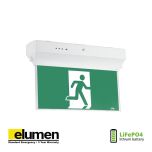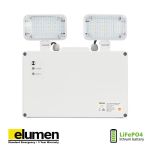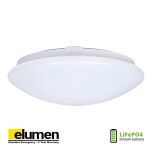To test an emergency lighting system, a mains power failure on the normal lighting circuit / circuits or individual luminaries must be simulated. This will force the emergency lighting system to operate via the battery supply. This test can be carried out manually or automatically.
Manual testing
A simulated mains failure can be achieved by providing a switch to isolate all lighting circuits / individual circuits / individual luminaires. If manual testing is utilised, the following points should be considered:
In a system with a single switch for the whole building or a large circuit, after simulating the mains failure it is necessary for the tester to walk the whole building or circuit, to check all emergency luminaire are operating correctly. After restoring the mains supply, the whole building or circuit must be walked again, to check that the emergency lights are recharging.
If the emergency luminaires are individually switched, only a single walk around the building will be needed. However, the test switches could spoil the decor of the building and they must be of a type that is tamper proof. After the tests, it is recommended that the performance of the system is logged in the fire safety logbook.
Automatic testing
If the costs of an engineer’s time and the disruption caused by manual testing are excessive, self-testing emergency lighting should be considered. Different formats are available to match particular site requirements. However, the results of the monthly and annual tests must still be recorded.
General information about emergency lighting testing
BS EN 50172:2004 / BS 5266-8:2004 (Emergency escape lighting systems) specifies the minimum provision and testing of emergency lighting for different premises. Additional information on servicing can be found in BS 5266-1: 2011 (Code of practice for the emergency lighting of premises).
Discharge tests need to be undertaken outside normal working hours. In buildings that are permanently occupied, the test should be phased so only alternate luminaires are tested.
Regular servicing is essential. The occupier / owner of the premises shall appoint a competent person to supervise servicing of the system. This person shall be given sufficient authority to ensure the carrying out of any work necessary to maintain the system in correct operational mode.
Because of the possibility of a failure of the normal lighting supply occurring shortly after a period of testing of the emergency lighting system or during the subsequent recharge period, all full duration tests shall, wherever possible, be undertaken just before a time of low risk to allow for battery recharge. Alternatively, suitable temporary arrangements shall be made until the batteries have been recharged.
The following minimum inspections and tests shall be carried out at the intervals recommended below. The regulating authority may require specific tests.
Daily emergency lighting inspection (only for central back-up systems)
This check only applies to emergency lighting systems with a central back-up battery system. In this case, there is a daily visual inspection of indicators on the central power supply to identify that the system is operational. No test of operation is required. This test does not apply to emergency lighting with self-contained back-up batteries in each unit (standard emergency lighting).
Monthly emergency lighting tests
All emergency lighting systems must be tested monthly. The test is a short functional test in accordance with BS EN 50172:2004 / BS 5266-8:2004.
The period of simulated failure should be sufficient for the purpose of this test while minimising damage to the system components, e.g. lamps. During this period, all luminaires and signs shall be checked to ensure that they are present, clean and functioning correctly.
Annual emergency lighting tests
A test for the full rated duration of the emergency lights (e.g. 3 hours) must be carried out. The emergency lights must still be working at the end of this test.
The result must be recorded and, if failures are detected, these must be remedied as soon as possible.
It is common for fire alarm servicing companies to carry out the annual emergency light ‘drain’ test at the same time as they carry out fire alarm system maintenance, as this fills the waiting time of the ‘drain’ test with useful activity.



